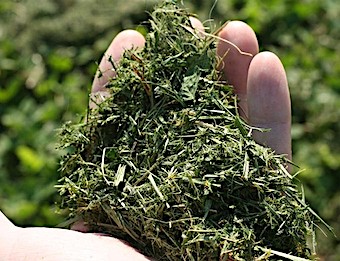Mow That Lawn
By Carmine Carosella, Fairfax Master Gardener
When it comes to lawn care, the most time-consuming job you have is the mowing. Doing it right will go a long way to having a great lawn. The three key steps are height of the cut, the frequency of the cut and the fate of the clippings.
 The lawn looks best when cut uniformly and edge-trimmed. Every time you cut the lawn, however, you limit the lawn’s ability to feed itself. This weakens the roots as they shut down to allow the leaves to regrow. The rule of thumb is to never cut more than one third of the grass plant. The ideal mowing height for cool season grasses such as tall fescue is about 3 inches. Warm season grasses such as Bermuda can be cut lower. Keeping these heights and maintaining the one third rule may require mowing of grass more than once a week in the rapidly growing seasons. If you let the lawn get too tall, then remember to still follow the one third rule. Remove only one third of the grass at a time every few days until you get down to the ideal height.
The lawn looks best when cut uniformly and edge-trimmed. Every time you cut the lawn, however, you limit the lawn’s ability to feed itself. This weakens the roots as they shut down to allow the leaves to regrow. The rule of thumb is to never cut more than one third of the grass plant. The ideal mowing height for cool season grasses such as tall fescue is about 3 inches. Warm season grasses such as Bermuda can be cut lower. Keeping these heights and maintaining the one third rule may require mowing of grass more than once a week in the rapidly growing seasons. If you let the lawn get too tall, then remember to still follow the one third rule. Remove only one third of the grass at a time every few days until you get down to the ideal height.
When a lawn is growing vigorously, you can cut it shorter than the ideal height, but when under stress such as from heat, shade or drought, it is better to leave the grass longer. Taller grass helps the soil retain moisture, and the shading of the taller grass will prevent some weeds from germinating. This gives the grass an edge over the weeds that seem to thrive in hot, dry summer conditions.
Most of us use rotary lawn mowers. They are easy to maintain and nowadays are very safe with their dead man switches. Reel lawn mowers can cut lower, but for home use only come as push types. They have trouble with taller and denser grass and are definitely slower than rotary lawn mowers. They are really only practical for small lawns. So, let’s talk just about mowing with a rotary lawn mower.

Clippings from a mulching mower
The other important point about the lawn mower blades is they must be kept sharp to work properly. Dull blades shred the grass which gives a brownish haze to the lawn as well as potentially inviting lawn disease. Rotary blades should be sharpened at least twice during the season. Warm season grasses such as zoysia dull the blades even faster and should be sharpened once a month. Do-it-yourselfers can easily sharpen their own rotary blades. First, disconnect the wire from the spark plug, then remove the blades with a wrench. Mount the blade in a vise and sharpen with a file. I use a belt sander to make short work of the sharpening. You also need a cone level to keep the blade in balance as you sharpen.
There are some obvious advantages of mowing your own lawn, although many people now default to lawn care companies for this task. Remember, the companies work on a schedule to suit their workload, not your lawn. They may have to come to you to mow every Wednesday morning, when the lawn is wet and with lawn mower blades that are no longer sharp. You observe your lawn closely and are in the best position to know when to mow.
To summarize, maintain your mowing equipment, especially the cutting blades. Observe the one third rule; never cut more than one third of the grass height at a time. Use mulching blades and leave the clippings on the lawn. Finally, keep the grass longer, close to 4 inches for cool season grasses, when the grass is under stress from heat, drought and shade.
References
The Lawn Bible, by David R. Mellor
Mow Like a Pro, Virginia Cooperative Extension